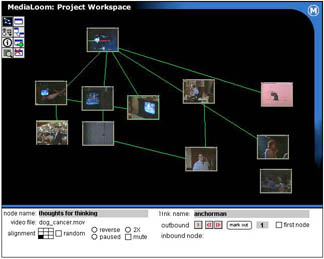To demonstrate the functionality of MediaLoom I have created a short work called Prisoner of Life. This hypervideo is a reconfiguration of about thirty minutes of Robert Altman's film Short Cuts, a clear cinematic forerunner of hypervideo. Altman takes great care to interweave nine short stories by Raymond Carver so that the individual storylines all seem to be happening simultaneously. The camera swerves in and out of these narrative streams encountering characters who also are able to move from story to story. It is as though we are watching a computer monitor over the shoulder of Altman who is directing the flow of a hypervideo.Short Cuts lends itself quite well to hypervideation for two reasons: 1) the film anticipates many of the storytelling strategies intrinsic to the hypervideo form; 2) there are associations and tangents that are obscured by the linearity of the filmic medium which might be highlighted (or discovered new) in the medium of hypervideo.The idea of using Short Cuts as a demonstration of hypervideo was suggested as a possible future use of the Engine in a paper by David Balcom called "Hypervideo: Notes Toward a Rhetoric" and in "Short Cuts, Narrative Film, and Hypertext".
One might ask: why choose a film as the subject of a hypervideo artifact? I would echo the video critic Michael Nash who believes that interactive video authors can learn much from traditional modes of storytelling. Specifically he refers to Altman's filmmaking technique whose work "follows the trails of coincidence, tangent, and narrative association … in 'sequential parallel.'" Altman's work represents a kind of linearized multi-linearity enforced only by the material properties of the film footage. In particular Nash points to Short Cuts as "a model of how a technologically interactive narrative might work to take us beyond technofetishistic games with computers into a spiritual journey." It is my hope that the viewer of this hypervideo will previously have seen Short Cuts (or other films by Altman) so that the uniqueness of the connections allowed by the hypervideation is more apparent.
Though the video artist Grahame Weinbren is mostly critical of the computer as a medium for interactive video, the hypervideated Short Cuts seems a perfect illustration of some of his ideas in an influential essay called "Ocean of Streams of Story". Weinbren, taking a cue from Salman Rushdie's Haroun and the Sea of Stories, asks "Can we image the Ocean as a source primarily for readers rather than writers? Could there be a 'story space' (to use Michael Joyce's resonant expression) like the Ocean, in which the reader might take a dip, encountering stories and story-segments as he or she flipped and dived. . . . What a goal to create such an Ocean! And how suitable an ideal for an interactive fiction!" Prisoner of Life sets as its goal the creation of simultaneously flowing storylines that can be navigated by swerving between streams.
The image above shows the construction of one segment of Prisoner of Life. The viewer can negotiate the "streams" (represented here as vertically arranged clips) by moving between them laterally. Time in this configuration exists on the y axis moving from top to bottom. Notice that the television screens (each showing the same newscast) link the streams together thematically as a single moment in time.
Return to Main Page
